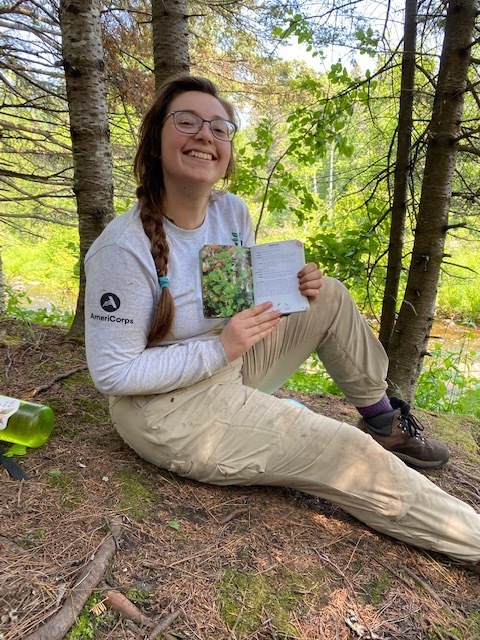Twinflower and the teachings of Summer Youth Corps

By Joanie Fieser, Summer Youth Corps Crew Leader / AmeriCorps Member
Two delicate pink flowers dangle like bells from a spindly stem poking up between lichen-laden rocks. I’m on my knees, hand-sawing a young aspen tree that’s bent over a trail in Tettegouche State Park. So close to the ground, the biologist in me can’t help but admire the structure of this precious little plant. I take a thoughtful look at it, memorizing the scalloped, round leaves and five fused petals. I continue with my work down the trail.
A bit later, my team member gets my attention and makes a chopping motion with one hand between the middle and ring fingers of the other– the ASL sign for break. I brush off my knees, take off my hard hat, gloves, and safety glasses, and walk over to my backpack. I fish Stan Tekiela’s Minnesota wildflowers guide book out of the front pocket and take a seat. I scan the glossy colored pages for the flower I saw between the rocks. The book is organized by flower color. I page past rose twisted-stalk, spreading dogbane, until… Aha! There it is, clear as day: twinflower. I smile at the name chosen for this plant. The thin, fuzzy stem splits in two, both sides holding up flowers swaddled in petals of the same pink. It reminds me of my cousin’s baby twin sons, always dressed in their matching twin outfits.
This has become a frequent practice of mine, this identifying of flowers during break. I am from Missouri, so many of the plants growing here on the North Shore of Superior are new to me. Everywhere I go, I feel a dutiful curiosity to notice the organisms around me. That spark has been in me as long as I can remember, though I acquired more specific tools to help me in school. Now, in the northern forest, I draw upon the methods I learned in a college course, Evolution of the Iowa Flora. I notice how and where the leaves are attached to the stem, the shape of the leaves, the symmetry of the flower, where the plant is growing, and what else is growing around it. Bunchberry, bluebead lily, star flower, nodding trillium, orange hawkweed; I greet them by their names as I haul trimmed branches off the trail. Slowly, I am learning about who lives here.
I am invigorated by the prospect of learning outside of the classroom, and know that even though my traditional schooling might be over, my learning about this world will never end. I graduated from Grinnell College in May, and knew I wanted to work outside with young people this summer. I was drawn to Summer Youth Corps because it has ample opportunity to learn. For example, some of my coworkers had never camped before staff training, many of us used a pulaski for the first time a few weeks ago, we are now equipped with a few conflict resolution tools, and I am borrowing this wildflower guide from the Corps. Further, my coworkers have patiently taught me some ASL, and I’ve realized it’s something I’d like to pursue further after this term of service. I am happy to say even at the end of long, tiring days on trail, I am grateful that SYC is the first step I chose to take off the commencement stage. Here’s to a summer of new places and new knowledge!
